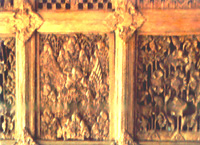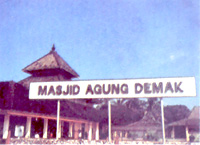|
|
As a brother of Sunan Bonang, Sunan Drajat also known as Syarifudin
or Raden Qosim, received religious teaching from his father Sunan
Ampel. Having learned enough, he moved to the village of Jelag.
Later the village was known as Drajat, Paciran Sub District, Lamongan
Regency.
The same as the other saints, Sunan Drajat also used "gamelan", Javanese music set, as a media of his spreading Islamic faith.
He created "Gending Pangkur", a kind of Javanese song,
to convert the local populace. Some fragments of these instruments
have been preserved and now can be witnessed in a small museum
next to the Sunan Drajat's tomb in Drajat Village, Paciran Sub
District, Lamongan regency.

Visit : Sunan Drajat Website

Sunan Kalijaga, whose first name is Raden Said, is a son of Tumenggung
Wilatikta, a regent of Tuban. Among then nine saints, he was known
as the great peace maker and wise leader. He received religious
teaching after an encounter with Sunan Bonang.
To spread Islamic faith, he centred his activities in Demak, Central
Java and built a mosque there. It was said that the mosque was
built in a single night by Wali Sanga. Sunan Kalijaga had a duty
to prepare and make a pillar, but he arrived late. He had no time
to prepare a tree trunk, therefore, he made up a pillar from planks
leftover by the other saints. So if you visit there you'll find
that one of the four pillars is larger than others, it is a creation
of Sunan Kalijaga.

He also used Javanese cultural performance as a media of his Islamic
teaching. Also, he had great contributions to the development
of gamelan, Javanese music set, as well as the leather puppet
shadow play. He created a layout of city, "gending Ilir-ilir"
song, "bedug", Garebeg Mulud (a kind of ritual ceremony)
and" Gong Sekaten". The later today is preserved in
the Central Java nese courts of Solo and Yogyakarta.
|
|

